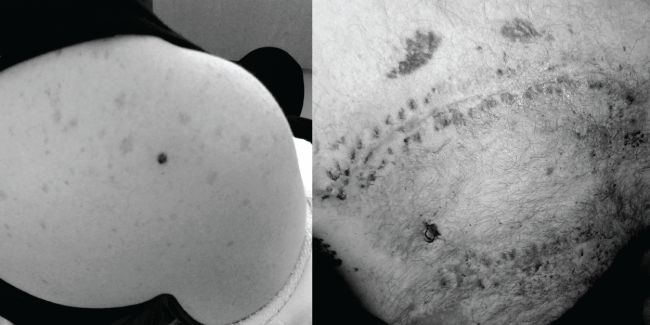International Journal of Surgery Research and Practice
Is Ligation an Option after Gunshut Injury of the Subclavian Artery?
Yucel Akkas1, Bulent Kocer1, Gultekin Gulbahar2*, Ahmet Gokhan Gundogdu2 and Bulent Ozkurt3
1Department of Thoracic Surgery, Ankara Numune Research and Training Hospital, Ankara, Turkey
2Department of Thoracic Surgery, Nafiz Korez Sincan State Hospital, Ankara, Turkey
3Department of Orthopaedics and Traumatology, Ankara Numune Research and Training Hospital, Ankara, Turkey
*Corresponding author: Gultekin Gulbahar, MD, Yasamkent mh. 3222. Cd. Besa Karina sitesi 3. Blok (Safir), Cayyolu, Cankaya/Ankara, Turkey, Tel: +90 505 335 95 31, E-mail: mdgultekin@gmail.com
Int J Surg Res Pract, IJSRP-3-038, (Volume 3, Issue 1), Case Report; ISSN: 2378-3397
Received: January 12, 2016 | Accepted: March 16, 2016 | Published: March 18, 2016
Citation: Akkas Y, Kocer B, Gulbahar G, Gundogdu AG, Ozkurt B (2016) Is Ligation an Option after Gunshut Injury of the Subclavian Artery?. Int J Surg Res Pract 3:038. 10.23937/2378-3397/1410038
Copyright: © 2016 Akkas Y, et al. This is an open-access article distributed under the terms of the Creative Commons Attribution License, which permits unrestricted use, distribution, and reproduction in any medium, provided the original author and source are credited.
Abstract
We would like to present this case to emphasize on the importance of rapid and accurate diagnosis leading to lifesaving emergent surgical approach. A 30 year-old male patient was taken to the emergency department after suffering from a gunshot wound. He had right subclavian artery injury. Right subclavian artery was ligated through an infraclavicular incision. The subclavian artery angiography, which was performed postoperatively, demonstrated the right axillary artery to be supplied by the collateral vasculature. The patient was discharged on the seventh postoperative day. Subclavian artery ligation may be performed for this kind of cases in which the hemodynamic state of the patient is critically poor or when the injury is in the distal part of the subclavian artery, if we can achieve positive radial signal from the doppler examination.
Keywords
Subclavian artery, Ligation, Gunshot injury, Surgical treatment
Introduction
Subclavian artery injury is rare. The diagnosis and treatment is difficult because of the complexity of the anatomic location [1,2]. We would like to present this case to emphasize the importance of rapid and accurate diagnosis leading to lifesaving emergent surgical approach.
Case Report
A 30 year old male patient was taken to the emergency department after suffering from a gunshot wound. The pulse rate was 130/min, arterial blood pressure was 80/50 mmHg and the respiratory rate was 30/min. On physical examination, there was a bullet entry wound on the posterior aspect of the right shoulder, and there was a bullet exit wound on the anterior aspect of the chest wall at the level of the fourth intercostal space and the midclavicular line on the right side. There was pulsatile blood discharge from the bullet exit wound (Figure 1). The right radial arterial pulse was palpable. The portable posteroanterior chest X-ray revealed no hemopneumothorax. The patient was taken to emergent surgery because of the poor hemodynamic state, pulsatile blood discharge from the right anterior chest wall and hematoma development in the right pectoral area. Initially subclavian artery injury was not suspected since the right radial pulse was palpable and the bullet exit wound was located on the fourth intercostal space. So the incision was started at the level of the bullet exit wound. But later on, when the injury of the subclavian artery was observed, infraclavicular incision was performed. Cardiopulmonary arrest developed due to hypovolemia. He got back to sinus rhythm after 15 minute perioperative resuscitation. On exploration, the subclavian artery was found to have complete rupture and the two ends of the ruptured segment were found to have been destroyed due to blast effect. Intraoperative portable doppler examination yielded positive radial signal, the general state of the patient was poor and he was about to bleed to death. So at first the subclavian artery was ligated using 3/0 polypropylene suture and the subclavian vein was repaired primarily using 4/0 polypropylene suture. Right subclavian artery angiography was performed postoperatively. The right subclavian artery was found to be occluded at the distal end, and the right axillary artery was reported to be supplied by the collateral vasculature (Figure 2). He was discharged on the seventh postoperative day and the neural repair was postponed to a later setting.

.
Figure 1: Bullet entry wound on the right shoulder, bullet exit wound on the anterior chest wall at the level of the fourth intercostal space and infraclavicular incision are seen.
View Figure 1

.
Figure 2: Occluded distal end of the right subclavian artery and the collateral supply of the right upper extremity are seen angiographically.
View Figure 2
Discussion
Only about 15% of the subclavian artery injury cases are lucky enough to reach a hospital setting [3].
Imaging methods may be used for the diagnosis of subclavian artery injury [2,3 ]. Angiography was performed postoperatively, and it was important for the demonstration of the collateral vasculature supplying the distal arterial system.
Different surgical approaches are preferred depending on the traumatized part of the artery in subclavian artery injury cases [2,3]. We preferred infraclavicular approach in our case because of the localization of the injury.
The primary surgical principle is repair by end to end anastomosis in subclavian artery injury. If a graft is needed for repair, the first choice is saphenous vein interposition. Synthetic grafts may also be used since the risk of infection is low due to the rich vascular supply of the area [1-4]. For the graft interposition, the two ends of the vasculature must be clean and in good shape. Ligation may be performed for cases in which the hemodynamic state of the patient is critically poor or when the injury is in the distal part of the subclavian artery [5]. Recently, endovascular stent implantation is performed, provided that the injury area is suitable and the rupture is incomplete [6]. Iyisoy et al. reported 42 year-old-woman with left subclavian artery occlusion in Behcet disease. In this case the saphaneous vein graft was placed between the left and right subclavian arteries [7]. Ozturk et al. reported 82-year-old-woman with subclavian artery dissection and rupture after the transcatheter aortic valve implantation procedure with axillary artery approach. In this case the right subclavian artery was ligated and a rapid surgical anastomosis with a dacron graft to the right subclavian-left subclavian was performed [8]. In our case, we had to ligate the subclavian artery because on our exploration the subclavian artery was found to have complete rupture and the two ends of the ruptured segments were found to have been destroyed due to the blast effect, the injury was in the distal part of the subclavian artery, the hemodynamic state of the patient was very poor being about to bleed to death and the Doppler US of the radial artery revealed distal flow pattern.
Brachial plexus damage may be left unrepaired due to emergent surgery need and the poor hemodynamic state of the patient [2,9]. In our case, the poor hemodynamic state of the patient did not let us repair the brachial plexus.
The mortality rate is 8-10% even in the most experienced centers in subclavian artery injury cases [9]. In our case we avoided mortality by means of rapid diagnosis and the appropriate surgical technique performed, although the hemodynamic state of the patient was unstable and he suffered from cardiopulmonary arrest.
Conclusion
Subclavian artery ligation may be performed for this kind of cases in which the hemodynamic state of the patient is critically poor or when the injury is in the distal part of the subclavian artery if we can achieve positive radial signal from the doppler examination.
Funding
This research received no specific grant from any funding agency in the public, commercial, or not-for-profit sectors.
Conflict of Interest
None declared
References
-
Tasdemir K, Oguzkaya F, Kahraman C, Ceyran H, Emirogullari Ö.N, et al. (1997) Artery injuries in upper extremity., Turk J Thorac Cardiovasc Surg 5: 218-222.
-
Posacioglu H, Yagdi T, Çalkavur T, et al. (1998) Surgical approach in subclavian artery injuries: Experience in ten years. Turk J Thorac Cardiovasc Surg 6: 45-52.
-
Kanko M, Yavuz S, Topçu S, Özbudak E, Berki T (2006) Geç bulgu veren penetran subklaviyan arter yaralanmasi:olgu sunumu. ADÜ Tip Fakültesi Dergisi 7: 43-45.
-
Lin PH, Koffron AJ, Guske PJ, Lujan HJ, Heilizer TJ, et al. (2003) Penetrating injuries of the subclavian artery. Am J Surg 185: 580-584.
-
Cheema M, Kirton OC, Lukose B, Gallagher J (2008) Ligation of the subclavian artery after blunt trauma presenting as massive hemothorax. J Trauma 64: 1126-1130.
-
Assenza M, Centonze L, Valesini L, Campana G, Corona M, et al. (2012) Traumatic subclavian arterial rupture: a case report and review of literature. World J Emerg Surg 7: 18.
-
Iyisoy A, Kursaklioglu H, Kose S, Yesilova Z, Ozturk C, et al. (2004) Acute myocardial infarction and left subclavian artery occlusion in Behçet's disease: a case report. Mt Sinai J Med 71: 330-334.
-
Ozturk C, Iyisoy A, Sahin MA, Tavlasoglu M, Celik T, et al. (2016) Left subclavian artery dissection and repair after transcatheter aortic valve implantation; the diameter of the axillary artery is important for axillary intervention. International Journal of Cardiology. 204: 77-80.
-
Melvin WS, Fitzpatrick JL (1992) Injuries of the thoracic outlet. Seminars in Thoracic and Cardiovascular Surgery 154:188-92.





